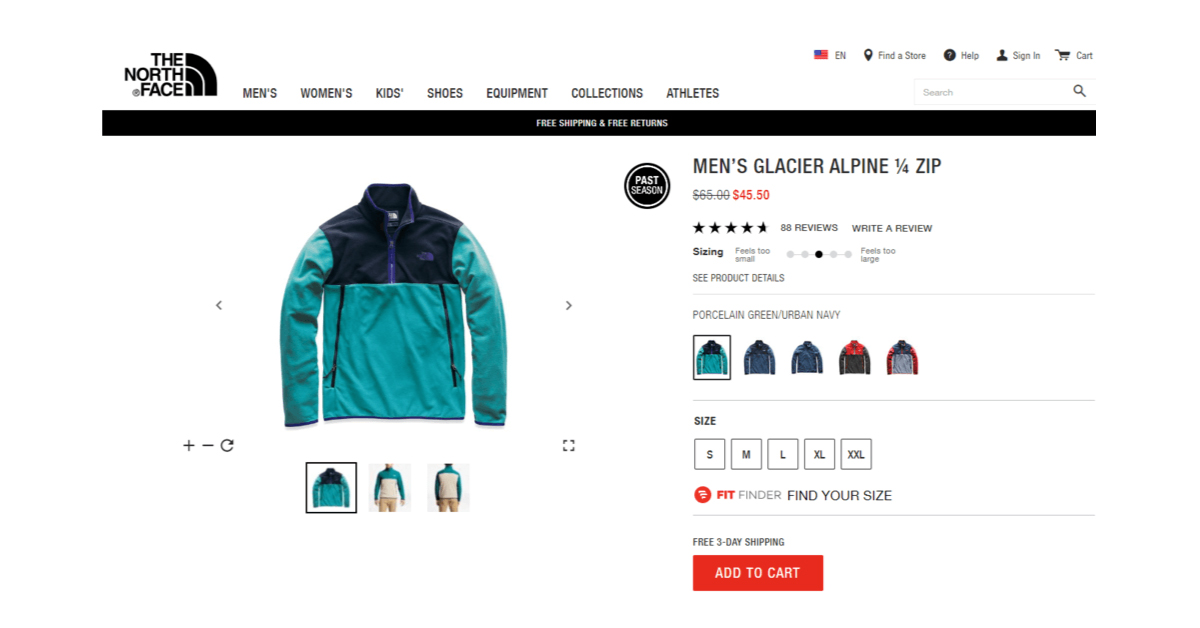What does it take to run a successful online business? An appealing website? Check. Compelling content? Check. An engaging social media strategy? Check.
You might have nailed all these things, but there’s one little component that’s often overlooked: the call to action (CTA).
In fact, 70% of small business B2B websites lack a call to action. It might surprise you, but foregoing these little buttons can have huge consequences for your business.
If you’re part of that statistic, don’t worry. In this article, we’re sharing everything we know about CTAs and how to write them.
What are CTAs?
In the marketing world, a call to action (CTA, for short) is a part of your advertisement, landing page, content offering, or email campaign that directs the viewer to take further action. Quite literally, it’s a “call” for your audience to take an “action”.
CTAs have always played a role in marketing and sales. However, as the digital world evolved, so too did the concept of what makes a great CTA.
The purpose of a CTAs all depends on the business and what they’re offering, however, we can outline three main CTA purposes:
- Offering the user something to reduce risk. This type of CTA is typically focused on the benefits of using their product or improving trust while nurturing them towards a buying decision.
- Directing the reader to the next step (click, share, sign up for a newsletter, etc).
- Encouraging the reader to act quickly by creating a sense of urgency or another compelling reason to follow the CTA.
For marketers, it’s important to figure out which CTAs work for a particular product, service, or other offering and which don’t. Think about how many CTAs your audience experience on a daily basis —they’re everywhere!— and come up with creative ways to make your CTAs stand out from the crowd.
What do CTAs look like?
A CTA can take many different forms. It might be a link at the end of a long-form blog article directing the reader to a downloadable resource. It can be an invitation to get in contact at the end of a campaign email. In web design, it typically takes the form of a banner, button, graphic, or text that prompts the viewer to click it as a next step.

Why do you need CTAs?
CTAs can often be an afterthought for marketers. After you’ve spent hours creating a great piece of content or weeks designing an incredible landing page—what’s so important about a tiny CTA at the end of the page?
The answer is simple: the CTA is how you accomplish your goals. It lets your audience know what they need to do. Without an effective CTA, the user might not know what steps they need to take next to purchase a product or service, download a valuable content offering, or sign up for your newsletter.
Ineffective CTAs can seriously compromise everything you’ve worked towards.
Check out the following statistics which sum up just how important CTAs are.
- More than 90% of visitors who read your headline also read your CTA copy.
- Adding CTAs to your Facebook page can increase the click-through rate by 285%.
- Emails with a single call-to-action increased clicks by 371% and sales by a whopping 1617%.
CTAs are integral to helping guide users towards conversion. However, understanding what kind of CTA to use can be challenging. The six tips below will help you to create powerful CTAs that resonate with your audience.
How to create a high-performing CTA in 6 simple steps
1. Outline your goal
In digital marketing, outlining your campaign goals is where it all begins. Whether you’re creating a landing page, a piece of content, or a PPC advertisement—you must link it to a wider marketing goal. The same goes for your call-to-action.
Your CTA should help guide customers to accomplishing a goal you’ve set out for them. They can be used to urge users to take all kinds of different actions, so it’s important to consider how your CTA aligns with your business goals.
Here are some examples of business goals you can use CTAs for:
-
- Lead generation: You want to convert website visitors into leads by offering free trials, consultations, content upgrades, etc. Place them where a lot of new visitors land like on your blog.
- Social sharing: Encourage visitors to share a piece of your content with their friends on social media. This is a low-commitment CTA that can help you to increase brand visibility and engagement.
- Lead nurturing: Offer something of value that aligns with your product offering to nurture leads towards conversion. Examples include free trials, product demos, free quotes, premium contents, etc.
- Conversion: The ultimate end goal. This type of CTA is sales-focused and invites the user to make a purchase or sign up for a service then and there.
You can use CTAs to help you achieve almost any marketing or sales goal. Once you know what you’re trying to achieve, you can create CTAs that are designed for success.
2. What channel are you using?
When creating CTAs, it’s important to consider which channel you’re using. Not everyone interacts with content in the same way. For example, users reading an email from your company will have different expectations from someone browsing through your blog or social feed.
For best results, be sure to tailor your CTAs to different platforms and content formats.
When installing CTAs on your website it’s important to consider the overall flow of the page. You might include CTAs as buttons or banners, but be sure to install them where users are most likely to see them.
CTAs are a vital part of your email campaign, so focus on text-based CTAs that link to your website or elsewhere. Blog CTAs are usually included at the end of a post and should be well-written and designed. Video CTAs are also extremely effective. Including a video in a CTA has shown to achieve a 380% jump in clicks when compared to CTAs located in a sidebar.
3. Use language to your advantage
Your CTA should tell the user what to do next clearly. Use actionable verbs that instruct the reader towards their next step. Don’t beat around the bush. Cut right to the chase with simple instructions that convince people to act.
If you run an eCommerce store, include CTAs like “buy now”, “shop now”, or “add to cart” to encourage conversions. If you want readers to subscribe to a newsletter or download premium content, consider words like “download” or “subscribe”. If you’re trying to encourage your audience to contact you, try “get in touch” or “talk to us”.
CTAs can be more than a few words and you can get as creative as you want, but remember to focus on the desired action and remove any distractions.

4. Tell your audience what’s in it for them
Your CTA should tell the user what’s in it for them. What do they get out of clicking the CTA? Whether your CTA encourages your audience to buy a product, download a white paper, or book an appointment, it should tie in with your unique selling point (USP).
Describe what value your audience is going to get from clicking a button or filling out a form. Will it help them to improve their business? Will it allow them to save money?
Combining your USP with your CTA is an effective way to acquire new leads and increase the click-through rate (CTR) of your CTA. A clear example of this in action is a CTA like “get in touch today to book a free consultation”. The user knows exactly what to do (get in touch) and what they’ll get out of it (a free consultation!)
5. Make it stand out
Words aren’t all that’s involved when it comes to creating effective CTAs. You’ll also need to think about its design and placement on the page. After all, a customer won’t be able to take the desired action if they can’t find your CTA in the first place!
Ensure the CTA stands out on the page and is easy to find. Use contrasting colors and make use of negative space to guide the user’s eyes towards the CTA button. Typically, CTAs work well when placed:
- Above the fold on a landing page.
- At the top of a page.
- At the end of a blog post.
- In the web page’s sidebar.
- In a welcome pop-up message.
- Embedded within email marketing content.
Consider the user experience (UX) when deciding where to place your CTA. Do they have to scroll to find it or is it available to them immediately? Strive to find a position for your CTA that’s accessible but not disruptive for the viewer.
Take the example below. The designer has used contrasting colors (green and purple) to make the CTA button stand out. What’s more, it’s located directly in the center of the page, which is where our eyes are naturally drawn to. The desired action (create your CV) is immediately clear to the reader, and the value is indicated below (you’ll be 65% more likely to get a job). Simple and effective.

6. Measure CTA performance
You won’t get far in the marketing world without measuring your performance. Try out different CTAs to find out which ones work best for your business. Experiment and get creative with colors, placement, video, and text to see which approach your target audience responds best to.
Revisit the goals that you defined when planning your digital marketing strategy and use relevant key performance indicators to measure the success of your CTAs. Remember, what works for one business might not work for another, so avoid comparison and keep experimenting until you find the approach that’s right for you.
Moving forward with CTAs that drive results
When done well, CTAs are powerful tools for achieving your business goals.
By providing your audience with a next step action, you’re helping them to make proactive decisions regarding their journey with your business. Well-designed CTAs that convince the user to take the desired action are essential to any content marketing, sales, or paid advertising strategy.
The first step? Find out who your audience is, what they want, and where they hang out. This will provide you with a stable foundation to build your digital marketing strategy around, and help you to better tailor your CTAs to appeal to your specific audience. Keep your eyes peeled because we’re about to hit you with our very own CTA.
Get to know your audience today.
Download our free buyer persona template.

